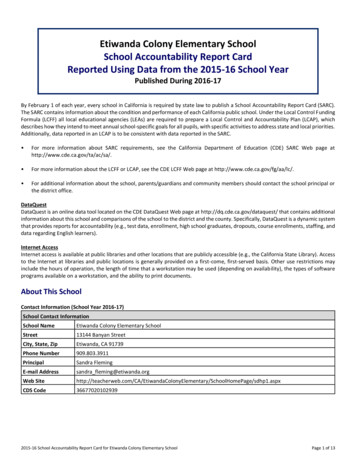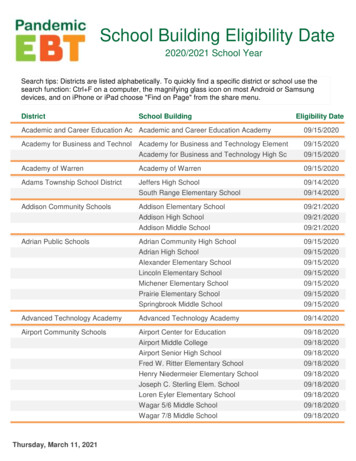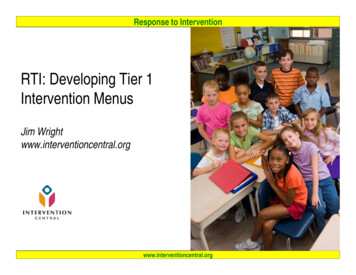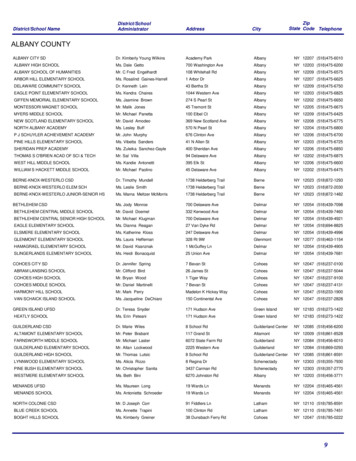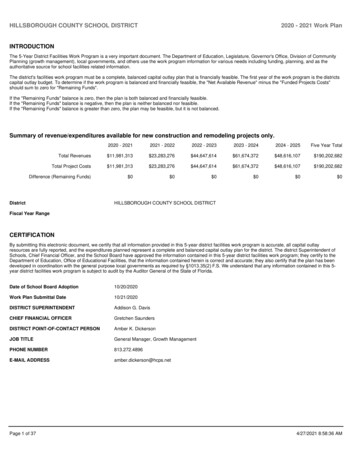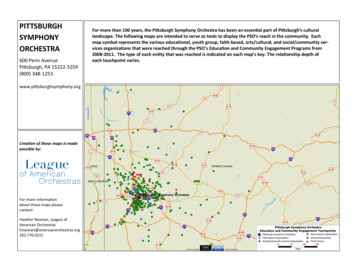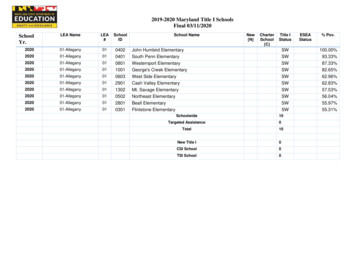
Transcription
Etiwanda Colony Elementary School2021 School Accountability Report Card------2021-22 School Accountability Report CardGeneral Information about the School Accountability Report Card (SARC)SARC OverviewBy February 1 of each year, every school in California is required by state law topublish a School Accountability Report Card (SARC). The SARC containsinformation about the condition and performance of each California public school.Under the Local Control Funding Formula (LCFF) all local educational agencies(LEAs) are required to prepare a Local Control and Accountability Plan (LCAP),which describes how they intend to meet annual school-specific goals for all pupils,with specific activities to address state and local priorities. Additionally, datareported in an LCAP is to be consistent with data reported in the SARC.For more information about SARC requirements and access to prior year reports,see the California Department of Education (CDE) SARC web page atwww.cde.ca.gov/ta/ac/sa/For more information about the LCFF or the LCAP, see the CDE LCFF web pageat www.cde.ca.gov/fg/aa/lc/For additional information about the school, parents/guardians and communitymembers should contact the school principal or the district office.DataQuestDataQuest is an online data tool located on the CDE DataQuest web page atdq.cde.ca.gov/dataquest/ that contains additional information about this school andcomparisons of the school to the district and the county. Specifically, DataQuest isa dynamic system that provides reports for accountability (e.g., test data,enrollment, high school graduates, dropouts, course enrollments, staffing, and dataregarding English learners).California School DashboardThe California School Dashboard (Dashboard) www.caschooldashboard.org/reflects California’s new accountability and continuous improvement system andprovides information about how LEAs and schools are meeting the needs ofCalifornia’s diverse student population. The Dashboard contains reports thatdisplay the performance of LEAs, schools, and student groups on a set of stateand local measures to assist in identifying strengths, challenges, and areas inneed of improvement.Internet AccessInternet access is available at public libraries and other locations that are publiclyaccessible (e.g., the California State Library). Access to the Internet at libraries andpublic locations is generally provided on a first-come, first-served basis. Other userestrictions may include the hours of operation, the length of time that a workstationmay be used (depending on availability), the types of software programs availableon a workstation, and the ability to print documents.2021-22 School Accountability Report CardPage 1 of 23Etiwanda Colony Elementary School
2021-22 School Contact Information2021-22 School Contact InformationSchool NameEtiwanda Colony Elementary SchoolStreet13144 Banyan StreetCity, State, ZipEtiwanda, CA 91739Phone Number909.803.3911PrincipalKerry HackmanEmail Addresskerry hackman@etiwanda.orgSchool ol (CDS) Code 366770201029392021-22 District Contact Information2021-22 District Contact InformationDistrict NameEtiwanda School DistrictPhone Number909.899.2451SuperintendentShawn Judson, Ed.D.Email Addressshawn judson@etiwanda.orgDistrict Website Addresswww.etiwanda.org2021-22 School Overview2021-22 School OverviewSCHOOL MISSIONThe staff of Etiwanda Colony Elementary School is committed to providing a quality education with an emphasis on academicsuccess and student self-esteem. We aim to provide all students with a positive, safe, orderly, and challenging learningenvironment that empowers them to become responsible and productive citizens.DISTRICT & SCHOOL PROFILEEtiwanda School District serves over 13,000 TK-8 students residing in the cities of Rancho Cucamonga, Fontana, Alta Loma,and Etiwanda. The district currently operates thirteen TK-5 elementary schools and four intermediate schools (grades 6-8) anda Community Day School. Etiwanda’s graduating eighth-grade students are served by Chaffey Joint Union High School Districtfor grades 9-12. The E.A.S.E. (Etiwanda Alternative Studies Education) and preschool program are provided at some schoolswithin the district. Childcare services are provided at all 17 school sites. More information is available on the district website orby contacting the district office at (909) 899-2451.The district’s commitment to excellence is achieved through a team of professionals dedicated to delivering a challenging, highquality educational program. Etiwanda School District appreciates the outstanding reputation it has achieved in local andneighboring communities. Consistent success in meeting student performance goals is directly attributed to the district’senergetic teaching staff and strong parent and community support.Etiwanda Colony is located in the heart of the Etiwanda community. Deriving its name from the original “Etiwanda Colony”Lands, the location was historically an agricultural area of citrus and stone fruits and frequented by sheep herders. EtiwandaColony is a part of the growing city of Rancho Cucamonga and serves almost 600 students. Etiwanda Colony first opened itsdoors to kindergarten through fifth grade students in the 2004-2005 school year. Outstanding and experienced staff, dedicatedstudents, and an involved, supportive parent partnership ensure Etiwanda Colony’s Cubs are “The Pride of Etiwanda.”District-sponsored, fee-based childcare is available Monday through Friday for Etiwanda Colony Elementary school-agestudents. The childcare program is open from 6:30 a.m. to 6:00 p.m. Participating students are provided enrichment activities inart, music, literature, and physical education. More information about the childcare program may be obtained from the districtwebsite or school office staff.-------2021-22 School Accountability Report CardPage 2 of 23Etiwanda Colony Elementary School
About this School2021-22 Student Enrollment by Grade Level2020-21 Student Enrollment by Grade LevelGrade LevelNumber of StudentsKindergarten123Grade 199Grade 282Grade 383Grade 4104Grade 588Total Enrollment5792020-21 Student Enrollment by Student Group2020-21 Student Enrollment by Student GroupStudent GroupPercent of Total EnrollmentAmerican Indian or Alaska Native0.3Asian12.4Black or African American4.5Filipino2.8Hispanic or Latino41.8Two or More Races6.6White28.5English Learners6.2Foster Youth0.5Homeless0.9Socioeconomically Disadvantaged19.7Students with Disabilities18A. Conditions of Learning (State Priority: Basic)A. Conditions of LearningState Priority: BasicThe SARC provides the following information relevant to the State priority: Basic(Priority 1): Degree to which teachers are appropriately assigned and fully credentialed inthe subject area and for the pupils they are teaching;Pupils have access to standards-aligned instructional materials; andSchool facilities are maintained in good repairNote: For more information refer to the Updated Teacher Equity Definitions webpage at ons.asp2021-22 School Accountability Report CardPage 3 of 23Etiwanda Colony Elementary School
2019-20 Teacher Preparation and Placement2019-20 Teacher Preparation and PlacementAuthorization/Assignment2019-20Fully (Preliminary or Clear) Credentialed for Subject and Student Placement (properly assigned)31Intern Credential Holders Properly Assigned0Teachers Without Credentials and Misassignments (“ineffective” under ESSA)0Credentialed Teachers Assigned Out-of-Field (“out-of-field” under ESSA)0Unknown0Total Teaching Positions31Note: The data in this table is based on Full Time Equivalent (FTE) status. One FTE equals one staff member working full time;one FTE could also represent two staff members who each work 50 percent of full time. Additionally, an assignment is defined asa position that an educator is assigned to based on setting, subject, and grade level. An authorization is defined as the servicesthat an educator is authorized to provide to students.2019-20 Teachers Without Credentials and Misassignments (considered “ineffective” under ESSA)2019-20 Teachers Without Credentials and Misassignments (considered “ineffective” under ESSA)Authorization/Assignment2019-20Permits and Waivers0Misassignments0Vacant Positions0Total Teachers Without Credentials and Misassignments02019-20 Credentialed Teachers Assigned Out-of-Field (considered “out-of-field” under ESSA)2019-20 Credentialed Teachers Assigned Out-of-Field (considered “out-of-field” under ESSA)Indicator2019-20Credentialed Teachers Authorized on a Permit or Waiver0Local Assignment Options0Total Out-of-Field Teachers02019-20 Class Assignments2019-20 Class AssignmentsIndicator2019-20Misassignments for English Learners(a percentage of all the classes with English learners taught by teachers that are misassigned)0No credential, permit or authorization to teach(a percentage of all the classes taught by teachers with no record of an authorization to teach)02021-22 School Accountability Report CardPage 4 of 23Etiwanda Colony Elementary School
2021-22 Quality, Currency, Availability of Textbooks and Other Instructional Materials2021-22 Quality, Currency, Availability of Textbooks and Other Instructional MaterialsAll textbooks used in the core curriculum throughout the Etiwanda School District are aligned to the California ContentStandards and Frameworks. Instructional materials for grades K-8 are selected from the state’s most recent list of standardsbased materials and adopted by the State Board of Education (SBE).LEAs are required to hold an annual public hearing by the end of the eighth week from the first day pupils attend school for thatyear. At the public hearing the governing board must determine, by resolution, whether each pupil in the district has sufficienttextbooks or instructional materials, or both, in reading/language arts, including the English language development componentof an adopted program, science, mathematics, and history–social science that are aligned to the State’s content standards andconsistent with the curriculum frameworks.On September 23, 2021, the Etiwanda School District’s Board of Trustees held a public hearing to certify the extent to whichtextbooks and instructional materials have been provided to students. The Board of Trustees adopted Resolution No. 2022-18stating the Etiwanda School District certifies that each pupil, including each English learner, has sufficient textbooks orinstructional materials which are aligned to the state content standards adopted pursuant to Education Code 60605 and/or theCommon Core Standards adopted pursuant to Education Code 60605.8 in the following subjects: mathematics, Englishlanguage arts (including an English language development component), science, and history-social science.Year and month in which the data were collectedSubjectSeptember 2021Textbooks and Other Instructional Materials/year sLacking OwnAssignedCopy0%Reading/Language ArtsMcGraw Hill "Wonders" (K-5) and "StudySync" (6-8)MathematicsHoughton Mifflin-Harcourt "Go Math!" (K-5) and Glencoe"California Math" (6-8)Yes0%Science"Amplify Science" (K-8)Yes0%History-Social ScienceHarcourt Brace "Reflections" (K-5) and Glencoe/McGraw-Hill"Discovering Our Past" (6-8)Yes0%2021-22 School Accountability Report CardPage 5 of 23Etiwanda Colony Elementary School
School Facility Conditions and Planned ImprovementsSchool Facility Conditions and Planned ImprovementsEtiwanda Colony Elementary provides a safe and clean environment for learning through proper facilities maintenance andcampus supervision. Original school buildings were constructed in 2004. Ongoing maintenance ensures school facilities arekept safe, in good working condition, and continue to provide adequate space for students and staff.Etiwanda Colony Elementary is proud of its high standards regarding campus maintenance and general housekeepingpractices. Staff and students enjoy the benefits of having a well-maintained and beautiful campus.School staff and the maintenance department work together to ensure playgrounds, classrooms, and campus grounds are wellmaintained. Maintenance and Operations (M&O) oversees a work order process enabling school staff to communicateunscheduled maintenance needs, urgent repairs, or special projects. Teachers, support staff, and the principal collaborateefforts to prepare and submit work orders to M&O for resolution. Emergency situations are given high priority and resolvedimmediately by site or district custodial staff. The principal, school secretary, and day custodian communicate each morning onan informal basis to discuss schedules, campus maintenance, and safety concerns. The director of maintenance andoperations (M&O) meets with the principal once a month to discuss maintenance-related issues associated with campusupkeep, safety, classroom space, equipment, upcoming events, work orders (submitted and outstanding), and specialrequests. The director of M&O checks in with the school custodian to see if there are items needed or concerns that need to beaddressed.Schools are required by state law to conduct a formal inspection annually of designated areas and systems and then prepare areport of the current condition of facilities. The School Site Inspection table illustrated in this report identifies the state-requiredinspection areas and discloses the operational status in each of those areas.Etiwanda Colony Elementary’s custodial staff is qualified and equipped to handle routine cleaning needs, general maintenance,and minor repairs. M&O provides formal training twice a year on the proper use of equipment, cleaning procedures, andchemical usage. One full-time day custodian is responsible for keeping the campus clean and fully operational. The custodian’sdaily routine includes cleaning the staff lounge, office, stocking student restrooms, and cleaning the cafeteria after meals areserved. Every morning before school begins, the day custodian inspects school facilities for safety hazards and maintenanceissues that require attention before staff and students arrive on campus. Restrooms are checked throughout the day as aproactive measure in keeping facilities stocked, sanitary, and safe. Any graffiti or signs of vandalism are removed immediately.A professional janitorial service is responsible for thoroughly cleaning classrooms and restrooms during the evenings. Thedistrict office dispatches a team of groundskeepers each week to maintain Etiwanda Colony Elementary’s landscaping andirrigation systems.Year and month of the most recent FIT reportSystem InspectedSystems:Gas Leaks, Mechanical/HVAC, SewerInterior:Interior SurfacesMarch 2021Rate Rate RateGood Fair PoorXXCleanliness:Overall Cleanliness, Pest/Vermin ms, Sinks/ FountainsXSafety:Fire Safety, Hazardous MaterialsX2021-22 School Accountability Report CardRepair Needed and Action Taken or PlannedBroken boys and girls restroom toilet seat coverdispensers were replaced (hardcourt). Removedbroken latch and installed a new one on the girlsrestroom partition doors.Page 6 of 23Etiwanda Colony Elementary School
School Facility Conditions and Planned ImprovementsStructural:Structural Damage, RoofsXExternal:Playground/School Grounds, Windows/Doors/Gates/FencesXVendor inspected site for repair/replace.Overall Facility RateOverall Facility RateExemplaryGoodFairPoorX2021-22 School Accountability Report CardPage 7 of 23Etiwanda Colony Elementary School
B. Pupil Outcomes (State Priority: Pupil Achievement)B. Pupil OutcomesState Priority: Pupil AchievementThe SARC provides the following information relevant to the State priority: PupilAchievement (Priority 4):Statewide Assessments(i.e., California Assessment of Student Performance and Progress [CAASPP]System includes the Smarter Balanced Summative Assessments for students inthe general education population and the California Alternate Assessments [CAAs]for English language arts/literacy [ELA] and mathematics given in grades threethrough eight and grade eleven. Only eligible students may participate in theadministration of the CAAs. CAAs items are aligned with alternate achievementstandards, which are linked with the Common Core State Standards [CCSS] forstudents with the most significant cognitive disabilities).The CAASPP System encompasses the following assessments and studentparticipation requirements:1. Smarter Balanced Summative Assessments and CAAs for ELA in gradesthree through eight and grade eleven.2. Smarter Balanced Summative Assessments and CAAs for mathematicsin grades three through eight and grade eleven.3. California Science Test (CAST) and CAAs for Science in grades five, eight,and once in high school (i.e., grade ten, eleven, or twelve).SARC Reporting in the 2020-2021 School Year OnlyWhere the most viable option, LEAs were required to administer the statewidesummative assessment in ELA and mathematics. Where a statewide summativeassessment was not the most viable option for the LEA (or for one or more gradelevel[s] within the LEA) due to the pandemic, LEAs were allowed to report resultsfrom a different assessment that met the criteria established by the State Board ofEducation (SBE) on March 16, 2021. The assessments were required to be: Aligned with CA CCSS for ELA and mathematics;Available to students in grades 3 through 8, and grade 11; andUniformly administered across a grade, grade span, school, or district to alleligible students.OptionsNote that the CAAs could only be administered in-person following health andsafety requirements. If it was not viable for the LEA to administer the CAAs inperson with health and safety guidelines in place, the LEA was directed to notadminister the tests. There were no other assessment options available for theCAAs. Schools administered the Smarter Balanced Summative Assessments forELA and mathematics, other assessments that meet the SBE criteria, or acombination of both, and they could only choose one of the following: Smarter Balanced ELA and mathematics summative assessments;Other assessments meeting the SBE criteria; orCombination of Smarter Balanced ELA and mathematics summativeassessments and other assessments.The percentage of students who have successfully completed courses that satisfythe requirements for entrance to the University of California and the California StateUniversity, or career technical education sequences or programs of study.2021-22 School Accountability Report CardPage 8 of 23Etiwanda Colony Elementary School
Percentage of Students Meeting or Exceeding the State Standard on CAASPPPercentage of Students Meeting or Exceeding the State Standard on CAASPPThis table displays CAASPP test results in ELA and mathematics for all students grades three through eight and grade eleventaking and completing a state-administered assessment.The 2019-2020 data cells with N/A values indicate that the 2019-2020 data are not available due to the COVID-19 pandemic andresulting summative test suspension. The Executive Order N-30-20 was issued which waived the assessment, accountability, andreporting requirements for the 2019-2020 school year.The 2020-2021 data cells have N/A values because these data are not comparable to other year data due to the COVID-19pandemic during the 2020-2021 school year. Where the CAASPP assessments in ELA and/or mathematics is not the most viableoption, the LEAs were allowed to administer local assessments. Therefore, the 2020-2021 data between school years for theschool, district, state are not an accurate comparison. As such, it is inappropriate to compare results of the 2020-2021 school yearto other school t2019-202020-212019-202020-212019-202020-21English Language Arts/LiteracyN/AN/AN/AN/AN/AN/A(grades 3-8 and 11)MathematicsN/AN/AN/AN/AN/AN/A(grades 3-8 and 11)2021-22 School Accountability Report CardPage 9 of 23Etiwanda Colony Elementary School
2020-21 CAASPP Test Results in ELA by Student Group2020-21 CAASPP Test Results in ELA by Student GroupThis table displays CAASPP test results in ELA by student group for students grades three through eight and grade eleven takingand completing a state-administered assessment. The CDE will populate this table for schools in cases where the schooladministered the CAASPP assessment. In cases where the school administered a local assessment instead of CAASPP, theCDE will populate this table with “NT” values, meaning this school did not test students using the CAASPP. See the localassessment(s) table for more dCAASPPPercentTestedCAASPPPercentNot TestedAll Students267NTNTNTCAASPPPercentMet an Indian or Alaska Native00000Asian25NTNTNTNTBlack or African ive Hawaiian or Pacific Islander00000Two or More Races22NTNTNTNTWhite76NTNTNTNTEnglish Learners15NTNTNTNTFoster oeconomically Disadvantaged56NTNTNTNTStudents Receiving Migrant Education Services00000Students with Disabilities54NTNTNTNTCAASPPStudent GroupsHispanic or Latino2021-22 School Accountability Report CardPage 10 of 23Etiwanda Colony Elementary School
2020-21 CAASPP Test Results in Math by Student Group2020-21 CAASPP Test Results in Math by Student GroupThis table displays CAASPP test results in Math by student group for students grades three through eight and grade eleven takingand completing a state-administered assessment. The CDE will populate this table for schools in cases where the schooladministered the CAASPP assessment. In cases where the school administered a local assessment instead of CAASPP, theCDE will populate this table with “NT” values, meaning this school did not test students using the CAASPP. See the localassessment(s) table for more dCAASPPPercentTestedCAASPPPercentNot TestedAll Students267NTNTNTCAASPPPercentMet an Indian or Alaska Native00000Asian25NTNTNTNTBlack or African ive Hawaiian or Pacific Islander00000Two or More Races22NTNTNTNTWhite76NTNTNTNTEnglish Learners15NTNTNTNTFoster oeconomically Disadvantaged56NTNTNTNTStudents Receiving Migrant Education Services00000Students with Disabilities54NTNTNTNTCAASPPStudent GroupsHispanic or Latino2020-21 Local Assessment Test Results in ELA by Student Group2020-21 Local Assessment Test Results in ELA by Student GroupThis table displays Local Assessment test results in ELA by student group for students grades three through eight and gradeeleven. LEAs/schools will populate this table for schools in cases where the school administered a local assessment. In caseswhere the school administered the CAASPP assessment, LEAs/schools will populate this table with “N/A” values in all cells,meaning this table is Not Applicable for this TotalNumberPercentPercentStudent GroupsAt or AboveEnrollmentTestedTestedNot TestedGrade LevelAll .44Male16015395.624.3859.48American Indian or Alaska Native0--------Asian2626100080.772021-22 School Accountability Report CardPage 11 of 23Etiwanda Colony Elementary School
Black or African 4.8450.85Native Hawaiian or Pacific Islander0--------Two or More Races1717100047.06White797594.945.0677.33English Learners1414100035.71Foster Youth11------Homeless65------Socioeconomically Disadvantaged565394.645.3650.94Students with Disabilities706897.14*At or above the grade-level standard in the context of the local assessment administered.2.8650Hispanic or Latino2020-21 Local Assessment Test Results in Math by Student Group2020-21 Local Assessment Test Results in Math by Student GroupThis table displays Local Assessment test results in Math by student group for students grades three through eight and gradeeleven. LEAs/schools will populate this table for schools in cases where the school administered a local assessment. In caseswhere the school administered the CAASPP assessment, LEAs/schools will populate this table with “N/A” values in all cells,meaning this table is Not Applicable for this TotalNumberPercentPercentStudent GroupsAt or AboveEnrollmentTestedTestedNot TestedGrade LevelAll .51Male16015093.756.2542American Indian or Alaska Native0--------Asian262596.153.8572Black or African 7.2626.09Native Hawaiian or Pacific Islander0--------Two or More Races1717100035.29White797493.676.3354.05English Learners141392.867.1423.08Foster Youth11------Homeless65------Socioeconomically Disadvantaged565394.645.3630.19Students with Disabilities706592.867.1433.85Hispanic or Latino*At or above the grade-level standard in the context of the local assessment administered.2021-22 School Accountability Report CardPage 12 of 23Etiwanda Colony Elementary School
CAASPP Test Results in Science for All StudentsCAASPP Test Results in Science for All StudentsThis table displays the percentage of all students grades five, eight, and High School meeting or exceeding the State Standard.The 2019-2020 data cells with N/A values indicate that the 2019-2020 data are not available due to the COVID-19 pandemic andresulting summative testing suspension. The Executive Order N-30-20 was issued which waived the assessment, accountability,and reporting requirements for the 2019-2020 school year.For any 2020-2021 data cells with N/T values indicate that this school did not test students using the CAASPP Science.SubjectScience(grades 5, 8 and high 28.722020-21 CAASPP Test Results in Science by Student Group2020-21 CAASPP Test Results in Science by Student GroupThis table displays CAASPP test results in Science by student group for students grades five, eight, and High School. For anydata cells with N/T values indicate that this school did not test students using the CAASPP rcentNot TestedPercentMet orExceededAll erican Indian or Alaska Native00000Asian--NTNTNTNTBlack or African American--NTNTNTNTFilipino--NTNTNTNTHispanic or Latino38NTNTNTNTNative Hawaiian or Pacific Islander00000Two or More Races--NTNTNTNTWhite22NTNTNTNTEnglish Learners--NTNTNTNTFoster oeconomically Disadvantaged20NTNTNTNTStudents Receiving Migrant Education Services00000Students with Disabilities18NTNTNTNTStudent Group2021-22 School Accountability Report CardPage 13 of 23Etiwanda Colony Elementary School
B. Pupil OutcomesState Priority: Other Pupil OutcomesThe SARC provides the following information relevant to the State priority: OtherPupil Outcomes (Priority 8): Pupil outcomes in the subject area of physicaleducation.B. Pupil Outcomes (State Priority: Other Pupil Outcomes)2020-21 California Physical Fitness Test Results2020-21 California Physical Fitness Test ResultsDue to the COVID-19 crisis, the Physical Fitness Test was suspended during the 2020-2021 school year and therefore no dataare reported and each cell in this table is populated with “N/A.”Percentage of Students Meeting Percentage of Students Meeting Percentage of Students MeetingGrade LevelFour of Six Fitness StandardsFive of Six Fitness StandardsSix of Six Fitness StandardsGrade 5N/AN/AN/AGrade 7N/AN/AN/AGrade 9N/AN/AN/AC. Engagement (State Priority: Parental Involvement)C. EngagementState Priority: Parental InvolvementThe SARC provides the following information relevant to the State priority: ParentalInvolvement (Priority 3): Efforts the school district makes to seek parent input inmaking decisions regarding the school district and at each school site.2021-22 Opportunities for Parental Involvement2021-22 Opportunities for Parental InvolvementParents are encouraged to be involved in their child’s learning process by attending school events, joining PTA, serving on aschool or PTA committee, and volunteering at the school. The staff welcomes parent assistance in the classroom, preparingclassroom materials, and chaperoning field trips. Back to School Night, Open House, student performances, Family Nights,Literature Week, Open House, and PTA-sponsored activities provide opportunities for parents to interact with school staff whilesupporting their child’s efforts. The School Site Council (SSC), ELAC (English Language Advisory Committee), Parent TeacherAssociation (PTA), and African American Parent and Educator Advisory Committee (AAPEAC) enable parents to provideoversight and input on the school budget, activities, fundraising projects, and educational programs. Parents who would like toget more involved or volunteer their time may contact the school office at (909) 803-3911. For the 2021-22 school year,COVID-19 health and safety guidelines have restricted in-person campus volunteers, afterschool student events, and familyengagement activities. However, families may still get involved in a variety of ways in a virtual environment, including attendingtheir child's conference, evening virtual parent events, helping prepare items at home, and continuing to keep in communicationwith their child's teacher.School-to-home communication takes place in a variety of formats. The school website features a wealth of informationincluding a calendar of events, school policies and procedures, PTA information, ELAC information, School Site Council
Etiwanda Colony is located in the heart of the Etiwanda community. Deriving its name from the original "Etiwanda Colony" Lands, the location was historically an agricultural area of citrus and stone fruits and frequented by sheep herders. Etiwanda Colony is a part of the growing city of Rancho Cucamonga and serves almost 600 students.
